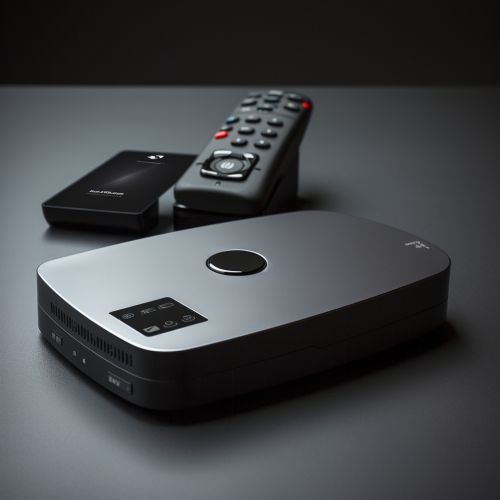Digital video recorder
Overview
A digital video recorder (DVR) is an electronic device that records video in a digital format to a disk drive, USB flash drive, SD memory card, SSD or other local or networked mass storage device. The term includes set-top boxes with direct to disk recording, portable media players and TV gateways with recording capability, and digital camcorders. Personal computers are often connected to video capture devices and used as DVRs; in such cases the application software used to record video is an integral part of the DVR. Many DVRs are classified as consumer electronic devices.


History
The development of the DVR has evolved over time, with the first systems being designed for the broadcast industry. The early systems were expensive and complex, but the advent of cheaper and more powerful computing hardware has made DVR technology accessible to the general public. The first consumer DVR was introduced by TiVo Inc. in 1999, which used a hard disk drive for storage and offered features such as pausing live TV and recording shows for later viewing.
Functionality
DVRs are designed to record and play back television programming. They have a multitude of features that differentiate them from traditional videocassette recorders (VCRs). These features include the ability to pause live television, rewind and fast-forward through recorded content, and schedule recordings for future programming. Some DVRs also offer features such as online streaming and mobile device compatibility, allowing users to watch recorded content on their smartphones or tablets.
Technology
DVR technology relies on a number of components to function. The most important of these is the hard drive, which stores the recorded video. DVRs also utilize video compression technology to reduce the size of the video files, allowing for more storage space. The DVR also requires a tuner to receive the television signal, and a processor to manage the recording and playback of content.
Impact
The introduction of the DVR has had a significant impact on the television industry. It has changed the way people watch television, allowing them to watch their favorite shows on their own schedule rather than being tied to the broadcast schedule. This has led to a shift in advertising strategies, as advertisers have had to find new ways to reach viewers who may be skipping commercials. The DVR has also had an impact on the legal landscape, with numerous lawsuits being filed over issues such as copyright infringement and patent disputes.
Future Developments
The future of the DVR is likely to be influenced by the ongoing shift towards streaming and on-demand content. As more people move away from traditional broadcast television, the need for a device to record live TV may decrease. However, DVRs may continue to evolve to meet the changing needs of consumers, potentially incorporating features such as cloud storage and advanced artificial intelligence capabilities.
